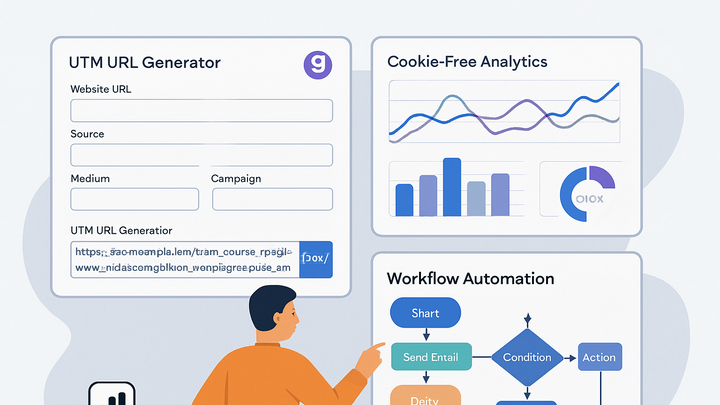Published on 2025-06-29T19:39:04Z
What is Marketing Automation in Campaign Tracking & Analytics?
Marketing Automation refers to the use of software platforms and technologies to automate repetitive marketing tasks such as email campaigns, social media scheduling, and ad management. It enables data-driven decision-making by collecting and analyzing campaign metrics in real time.
In campaign tracking & analytics, automation platforms streamline data flows, trigger responses based on audience behavior, and generate actionable insights without manual intervention. By automating workflows, marketers can deliver personalized experiences at scale, improve ROI, and focus on strategic initiatives rather than manual execution.
Popular tools in this space include cookie-free analytics platforms like plainSignal for privacy-focused tracking and UTM management solutions like utmGuru.com for building and organizing UTM-tagged URLs.
Marketing automation
Automates campaign tasks to segment audiences, manage UTM parameters, and collect cookie-free analytics with minimal manual effort.
Understanding Marketing Automation
Marketing Automation uses software to automate repetitive marketing activities, such as email distribution, social media scheduling, and ad management. It captures and processes campaign data across multiple channels, ensuring that audience interactions are tracked, segmented, and acted upon without manual intervention. This capability lays the groundwork for personalized engagement at scale and continuous optimization of marketing efforts.
-
Definition & scope
Marketing automation encompasses tools and workflows that automate tasks across the marketing lifecycle—from lead capture and nurturing to campaign analysis and reporting.
-
Core objectives
The primary objectives of marketing automation are:
- Efficiency: Reduce manual workload by automating routine tasks.
- Personalization: Deliver targeted messages based on user behavior and data.
- Scalability: Manage high-volume campaigns without additional resources.
-
Relevance to campaign tracking
By integrating with analytics tools and UTM builders, marketing automation enhances campaign tracking accuracy and enables real-time reactions to audience behavior.
Key Components of Marketing Automation
Effective marketing automation comprises several core components that work together to manage, execute, and analyze campaigns. These building blocks ensure tracking data is captured, processed, and acted upon seamlessly.
-
Segmentation & targeting
Behavioral Segmentation: Group users based on actions like page views, link clicks, and form submissions.
Demographic Segmentation: Target audiences by attributes such as location, job title, or industry.
-
Workflow automation
Defines triggers, rules, and actions that execute automatically when specific conditions are met, reducing manual intervention and improving response times.
- Triggers:
Event-based conditions like a specific UTM parameter match, form submission, or pageview occurrence.
- Actions:
Automated outputs such as sending emails, updating CRM records, or applying tags.
- Triggers:
-
Reporting & analytics
Centralizes data visualization with dashboards, custom reports, and alerts, providing insights into campaign performance and user behavior.
- Dashboards:
Visual summaries of key metrics like open rates, click-through rates, and conversion rates.
- Alerts:
Notifications triggered by threshold breaches (e.g., high bounce rate) or unusual activity patterns.
- Dashboards:
SaaS Tools & Integrations
Integrating specialized SaaS tools like plainSignal and utmGuru enhances marketing automation by ensuring accurate tracking and streamlined UTM parameter management.
-
Plainsignal (cookie-free simple analytics)
PlainSignal offers lightweight, privacy-friendly analytics that track pageviews and events without using cookies. It seamlessly integrates into automation workflows to provide real-time insights while respecting user privacy.
- Integration snippet:
<link rel="preconnect" href="//eu.plainsignal.com/" crossorigin /> <script defer data-do="yourwebsitedomain.com" data-id="0GQV1xmtzQQ" data-api="//eu.plainsignal.com" src="//cdn.plainsignal.com/plainsignal-min.js"></script> - Use cases:
Monitor landing page performance, trigger segmentation based on page interactions, and feed real-time data into workflow rules.
- Integration snippet:
-
Utmguru.com (utm builder & manager)
utmGuru simplifies the creation, management, and organization of UTM-tagged URLs, ensuring consistency and accuracy across marketing campaigns.
- Creating utm urls:
Use the web interface or Chrome extension to define parameters such as
utm_source,utm_medium,utm_campaign,utm_term, andutm_content. - Saving & organizing:
Store, categorize, and search UTM templates for reuse, reducing parameter errors and streamlining team collaboration.
- Creating utm urls:
Best Practices & Implementation Tips
Adhering to best practices ensures reliable data, efficient workflows, and scalable marketing automation.
-
Define clear goals
Align automation workflows with specific marketing objectives—such as lead acquisition, customer retention, or upsell campaigns—to measure success effectively.
-
Maintain data hygiene
Consistent naming conventions and regular audits prevent data fragmentation and ensure accurate reporting.
- Consistent utm naming:
Adopt a standardized schema (e.g.,
source_medium_campaign) and apply it across all URLs. - Regular audits:
Review analytics dashboards and UTM lists weekly to identify typos, duplicates, or inactive campaigns.
- Consistent utm naming:
-
Test & iterate
Continuously validate tracking setups and workflow rules in staging environments before full deployment to catch errors early.
- A/b testing:
Experiment with different workflow triggers, email content, or segmentation criteria to optimize performance.
- Validation checks:
Verify that event data and UTM parameters appear correctly in analytics platforms after each change.
- A/b testing:
